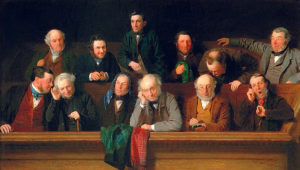In B.C., not all trials can be heard by a jury. Actions against the Crown and family law proceedings must be heard by judge alone. Civil trials, such as personal injury, can be heard by judge alone or judge and jury.
In a recent 2-week personal injury trial, the jury returned a verdict in our favour. But is justice always served by a jury in personal injury matters?
In a jury trial, the judge and jury work together. The jury judges the facts and evidence, and the judge clarifies the law. The ultimate decision is in the jury’s hands, and poses no real problem except on one significant point: non-pecuniary damages.
Non-pecuniary damages compensate for pain, injury, suffering, and loss of enjoyment of life. In 1978, the Supreme Court of Canada implemented a judicial “cap” of $100,000, which can only be adjusted for inflation, about $350,000 today. The maximum is only awarded for truly catastrophic injuries.
In a judge alone trial, both plaintiff and defence lawyers present prior judgments of non-pecuniary damages they believe are appropriate to compensate the plaintiff. The judge then determines which amount closely reflects the case at trial.
This is not the case with a jury. Sadly, neither the judge nor lawyers are allowed to give the jury any examples of trial judgments, or even mention award amounts in other cases. This leaves the jury in a vacuum. In our recent case, the jury pleaded for the Court’s guidance for an approximation for compensation. The law, however, prevented that.
If the jury awards a non-pecuniary amount over the cap, it would appear the community is telling the court the cap is set too low. However, the verdict is inevitably reversed through appeal, effectively ignoring the community’s view.
As one example, in Lee v. Dawson, 2003 BCSC 1012, the jury awarded the plaintiff $2 million in non-pecuniary damages. The trial judge adjusted it down to $294,000, the cap adjusted for inflation. The BC Court of Appeal dismissed the appeal, and the Supreme Court of Canada refused to hear it. No matter the view of the community, the Court has no desire to revisit the cap on non-pecuniary damages.
Without even taking into account the inadequate selection process or the extra time and money incurred for trial by jury, is justice truly served when non-pecuniary verdicts are based only on guesswork? How is that fair to the jury or to the plaintiff?
In a personal injury trial, are “justice” and “the jury” mutually exclusive terms?
What do you think?
You need someone truly on your side. Why settle for less?
Contact Einfeld Law for a free, initial consultation by phone at (250) 712-0001, visit our website at www.einfeldlaw.com, or find us on facebook.
Einfeld Law is a highly knowledgeable and experienced BC personal injury law firm specializing in motor vehicle accidents, motorcycle accidents, and other negligence claims involving bodily injury. We have successfully litigated many ICBC and other insurance claims, including out of province, wrongful death, brain injury, spinal cord injury, whiplash, soft tissue injury, and all other bodily injury claims. We have collected millions of dollars on behalf of our clients. We never act for ICBC or other insurance companies.


Comments are closed